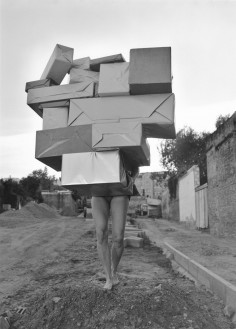Carina Brandes

source: contemporaryartdaily
Carina Brandes’s b&w photographs are not documentary photographs that represent the objective reality and not simply visualizations of a subjective world outlook. And even if her own body is the subject of most of her photographs, they are not self- portraits. The artist does not use the medium of photography in order to examine the reality of her environments, to investigate the borders of the subject and her own identity; nor does the medium function as a third, optimized eye providing a sharpened view of reality. Yet with her works Brandes opens a perspective on something that lies beyond the ordinary and the well-known: she shows us what is possible, what is slumbering within the banality of everyday-life and what can be discovered there.
With her photographs, Brandes offers an insight into secluded sceneries showing her at peculiar and isolated places, sometimes in company of other women or of animals. The photos are taken by means of automatic release while the characters are inter- acting with some props and with their surroundings. They obliviously seem to follow a secret plan, not being aware of them- selves and of the eye of the camera; they appear as one with the environment, free of any doubt about their action, operating with inanimate props in a way that makes them seem alive and in correspondence with the persons and the surroundings. The pictured scenery is thus provided with cinematographic character; perhaps reminds one even more of a theatric staging, especi- ally because the subjects of the photos reference classical symbols and art-historical themes, allegoric motifs, mythemes, and archetypes that originate in the unconscious. This, incidently, is the reason why the settings seem slightly intimate to us despite of their obscurity. Brandes transfers all these solemn motifs into ordinary and prosaic daily life, to small-town surroundings or industrial venues. She provides them with the casual, subtle charm of the aesthetics of banal everyday-life that is free from pathos, from psychoanalytical truisms and from esoteric allusions. Her metamorphoses are rather based on the lust for trans- formation and disguise. They invite us to get spellbound by the miracles of everyday-life.

